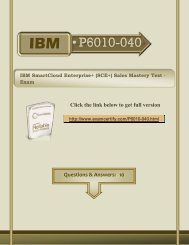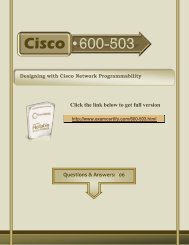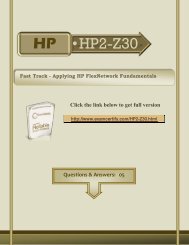Cisco
You also want an ePaper? Increase the reach of your titles
YUMPU automatically turns print PDFs into web optimized ePapers that Google loves.
<strong>Cisco</strong><br />
•350-029<br />
CCIE Service Provider Written exam<br />
Click the link below to get full version<br />
http://www.examcertify.com/350-029.html<br />
Questions & Answers: 20
Question: 1<br />
Which two statements about the bgp deterministic-med and bgp always-compare-med commands<br />
are true? (Choose two)<br />
A. The bgp deterministic-med command is used to influence the BGP route selection process to<br />
cause the MED attribute to have higher precedence over the AS path length<br />
B. The bgp always-compare command is used to influence the BGP route selection process to cause<br />
the MED attribute to have higher precedence over the AS path system.<br />
C. Enabling the bgp deterministic-med command ensures the comparison of the MED variable when<br />
choosing routes advertised by different peers in the same autonomous system.<br />
D. Enabling the bgp always-compare-med command ensures the comparison of the MED variable for<br />
paths from neighbors in different autonomous systems.<br />
E. The bgp deterministic-med and bgp always-compare-med commands are enabled by defult.<br />
Answer: C,D<br />
Explanation:<br />
Enabling the bgp deterministic-med command ensures the comparison of the MED variable when<br />
choosing routes advertised by different peers in the same autonomous system. Enabling the bgp<br />
always-compare-med command ensures the comparison of the MED for paths from neighbors in<br />
different autonomous systems.<br />
NotE. The bgp deterministic-med and bgp always-compare-med commands are not enabled by<br />
default. Also, the two commands are separate; enabling one does not automatically enable the<br />
other.<br />
Question: 2<br />
Which two statements are true about SAFI & AFI?<br />
A. Subsequent Address Family identifier (SAFI) provides additional information about the type of the<br />
Network Layer ports carried in the BGP update B. Address Family identifier (AFI) field carries the<br />
identity of the Network Layer ports for which the BGP speaker intends to advertise multiple paths<br />
C. Subsequent Address Family identifier (SAFI) provides additional information about the type of the<br />
Network Layer Reachability Information carried in the attribute<br />
D. Address Family identifier (AFI) carries the identity of the Network Layer protocol for which the<br />
BGP speaker intends to advertise multiple paths<br />
Answer: C,D<br />
http://www.examcertify.com/350-029.html Page 2
Question: 3<br />
Which 4 statements regarding MPLS Label Stack Encoding is true?<br />
A. A value of 4 represents the "Implicit NULL Label."<br />
B. A value of 0 represents the "IPv4 Explicit NULL Label."<br />
C. A value of 1 represents the "Router Alert Label".<br />
D. A value of 2 represents the "IPv6 Explicit NULL Label"<br />
E. A value of 1 represents the "IPv1 Explicit NULL Label"<br />
F. A value of 3 represents the "Implicit NULL Label"<br />
Answer: B,C,D,F<br />
Explanation:<br />
A value of 0 represents the "IPv4 Explicit NULL Label". This label indicates that the label stack must<br />
be popped, and the packet forwarding must be based on the IPv4 header. This helps to keep Exp bits<br />
safe until the egress router. It is used in MPLS based QoS. A value of 1 represents the "Router Alert<br />
Label". When a received packet contains this label value at the top of the label stack, it is delivered to<br />
a local software module for processing. The actual packet forwarding is determined by the label<br />
beneath it in the stack. However, if the packet is forwarded further, the Router Alert Label should be<br />
pushed back onto the label stack before forwarding. The use of this label is analogous to the use of<br />
the "Router Alert Option" in IP packets (for example, ping with record route option)<br />
A value of 2 represents the "IPv6 Explicit NULL Label". It indicates that the label stack must be<br />
popped, and the packet forwarding must be based on the IPv6 header. A value of 3 represents the<br />
"Implicit NULL Label". This is a label that an LSR can assign and distribute. However, it never actually<br />
appears in the encapsulation. It indicates that the LSR pops the top label from the stack and<br />
forwards the rest of the packet (labeled or unlabeled) through the outgoing interface (as per the<br />
entry in Lfib). Although this value might never appear in the encapsulation, it needs to be specified in<br />
the Label Distribution Protocol, so a value is reserved.<br />
Question: 4<br />
Which of the following technologies can improve convergence time following a link failure in a<br />
service provider network? (Choose two.)<br />
A. RSVP<br />
B. MPLS TE FR<br />
C. MPLS VPN<br />
D. SNMP<br />
E. BFD<br />
F. VPLS<br />
http://www.examcertify.com/350-029.html Page 3
Answer: B,E<br />
Question: 5<br />
router bgp 1<br />
neighbor 1.1.1.1 remote-as 2<br />
The above bgp configuration has what effect on the configured router?<br />
A. Allows incoming TCP connections from 1.1.1.1 that are sourced from port 179<br />
B. Allows incoming TCP connections from 1.1.1.1 that are destined to port 179<br />
C. Allows incoming TCP connections sourced from port 179<br />
D. Allows incoming TCP connections from 1.1.1.1 and destined to or sourced from port 179<br />
E. Allows incoming TCP connections destined to port 179<br />
Answer: B<br />
Question: 6<br />
Which configuration prevents traffic that is sourced from the unique local address scope to be sent<br />
out of the link to the upstream service provider?<br />
A. interface ethernet0/0 ipv6 traffic-filter NoULA out ! ipv6 access-list NoULA deny ipv6 FC00::/8 any<br />
permit ipv6 any any<br />
B. interface ethernet0/0 ipv6 traffic-filter NoULA out ! ipv6 access-list NoULA deny ipv6 FC00::/7 any<br />
permit ipv6 any any<br />
C. interface ethernet0/0 ipv6 access-group NoULA out ! ipv6 access-list NoULA deny ipv6 FC00::/8<br />
any permit ipv6 any any<br />
D. interface ethernet0/0 ipv6 access-group NoULA out ! ipv6 access-list NoULA deny ipv6 FC00::/7<br />
any permit ipv6 any any<br />
Answer: B<br />
Explanation:<br />
A unique local address (ULA) is an IPv6 address in the block fc00::/7, defined in RFC 4193. It is the<br />
approximate IPv6 counterpart of the IPv4 private address. Unique local addresses are available for<br />
use in private networks, e.g. inside a single site or organization or spanning a limited number of sites<br />
or organizations.<br />
They are not routable in the global IPv6 Internet. With our IPv6 ACL completed, we just need to<br />
apply it to an interface. There is a minor difference in syntax herE. instead of using the command ip<br />
http://www.examcertify.com/350-029.html Page 4
access-group to apply our IPv6 ACL, we use the more aptly named command ipv6 traffic-filter,<br />
followed by the ACL name and a direction (in this case, "out").<br />
Question: 7<br />
What is the order of preference for these commands when all of them are applied to one neighbor in<br />
the BGP inbound filter direction?<br />
A. prefix-list/distribute-list, filter-list, route-map<br />
B. route-map, filter-list, prefix-list/distribute-list<br />
C. route-map, prefix-list/distribute-list, filter-list<br />
D. filter-list, prefix-list/distribute-list, route-map<br />
E. prefix-list/distribute-list, route-map, filter-list<br />
Answer: B<br />
Question: 8<br />
Select the two answers that best describe the IP Event Dampening feature.<br />
A. The IP Event Dampening uses exponential decay mechanism to suppress the effects of excessive<br />
interface flapping<br />
B. BGP Operators use IP Event Dampening to suppress the effect of unstable internet Routes<br />
C. The IP Event Dampening works with routing protocols by stopping the announcement of<br />
dampened Interface subnets in their updates<br />
D. When IP Event Dampened internet routes reach their re-use limit, BGP installs them in the Routing<br />
Table and announces them to other BGP speakers<br />
Explanation:<br />
1.10. High Availability<br />
Answer: A,C<br />
Question: 9<br />
Which statement about MPLS TE Fast Reroute (FRR) node protection operation is not correct?<br />
A. It requires a next-next hop backup tunnel.<br />
B. Point of local repair (PLR) swaps the next hop label and pushes the backup label.<br />
http://www.examcertify.com/350-029.html Page 5
C. The backup tunnel terminates on the merge point (MP) where traffic rejoins the primary tunnel.<br />
D. The backup tunnel can have associated bandwidth capacity.<br />
E. Restoration time is expected under 50 ms.<br />
Answer: E<br />
Explanation:<br />
1.7. MPLS Traffic Engineering Restoration time depends on failure detection time.<br />
Question: 10<br />
Based on the following output in R1, which statement is truE. R1#show mpls forwarding-table<br />
50.0.0.3 detail<br />
Local Outgoing Prefix Bytes Label Outgoing Next Hop<br />
Label Label or Tunnel Id Switched interface<br />
19 17 50.0.0.3/32 0 Et0/0 192.168.0.14<br />
A. If a labeled packet arrives with the topmost label of 17, all the labels will be removed and a clear IP<br />
packet is sent to Next Hop 192.168.0.14 on Ethernet 0/0.<br />
B. If a labeled packet arrives with the topmost label of 17, the label is replaced with label 19 and the<br />
packet is sent out on the Ethernet 0/0 interface.<br />
C. If a labeled packet arrives with the topmost label of 19, the label is replaced with label 17 and the<br />
packet is sent out on the Ethernet 0/1 interface.<br />
D. If a labeled packet arrives with the topmost label of 19, the label is replaced with label 17 and the<br />
packet is sent out on the Ethernet 0/0 interface.<br />
Answer: D<br />
Question: 11<br />
Which three of these are optical channel data unit (ODU) overhead fields? (Choose three)<br />
A. general communication channel 0 (GCC0)<br />
B. section monitoring<br />
C. reserved (RES)<br />
D. general communication channels 1 and 2 (GCC1 GCC2)<br />
E. tandem connection monitoring activation deactivation (TCM ACT)<br />
Answer: C,D,E<br />
http://www.examcertify.com/350-029.html Page 6
Explanation:<br />
Optical Data Unit (ODU) The ODU overhead is broken into several fields: RES, PM, TCMi, TCM ACT,<br />
FTFL, EXP, GCC1/GCC2 and APS/PCC. The reserved (RES) bytes are undefined and are set aside for<br />
future applications.<br />
The path monitoring (PM) field is similar to the SM field described above. It contains the TTI, BIP-8,<br />
BEI, BDI and Status (STAT) sub-fields.<br />
There are six tandem connection monitoring (TCMi) fields that define the ODU TCM sub-layer, each<br />
containing TTI, BIP-8, BEI/BIAE, BDI and STAT sub-fields associated to each TCM level (i=1 to 6). The<br />
STAT sub-field is used in the PM and TCMi fields to provide an indication of the presence or absence<br />
of maintenance signals.<br />
The tandem connection monitoring activation/deactivation (TCM ACT) field is currently undefined in<br />
the standards. The fault type and fault location reporting communication channel (FTFL) field is used<br />
to create a message spread over a 256-byte multiframe. It provides the ability to send forward and<br />
backward path-level fault indications.<br />
The experimental (EXP) field is a field that is not subject to standards and is available for network<br />
operator applications.<br />
General communication channels 1 and 2 (GCC1/GCC2) fields are very similar to the GCC0 field except<br />
that each channel is available in the ODU. The automatic protection switching and protection<br />
communication channel (APS/PCC) supports up to eight levels of nested APS/PCC signals, which are<br />
associated to a dedicated-connection monitoring level depending on the value of the multiframe.<br />
Question: 12<br />
Which three modes are the operating of HDLC? (Choose three)<br />
A. asynchronous balanced mode (ABM)<br />
B. normal response mode (NRM)<br />
C. normal peer mode (NPM)<br />
D. asynchronous client mode (ACM)<br />
E. asynchronous response mode (ARM)<br />
Answer: A,B,E<br />
Explanation:<br />
Normal response mode allows operation over half-duplex communication links, as long as the<br />
primary is aware that it may not transmit when it has given permission to a secondary. Asynchronous<br />
response mode is an HDLC addition[1] for use over full-duplex links. While retaining the<br />
primary/secondary distinction, it allows the secondary to transmit at any time. Asynchronous<br />
balanced mode added the concept of a combined terminal which can act as both a primary and a<br />
secondary. There are some subtleties about this mode of operation; while many features of the<br />
protocol do not care whether they are in a command or response frame, some do, and the address<br />
field of a received frame must be examined to determine whether it contains a command (the<br />
address received is ours) or a response (the address received is that of the other terminal).<br />
http://www.examcertify.com/350-029.html Page 7
Question: 13<br />
Which four of these are MPLS label header fields? (Choose four.)<br />
A. Label<br />
B. VPI VCI<br />
C. EXP<br />
D. TTL<br />
E. FCS<br />
F. S flag<br />
Answer: A,C,D,F<br />
Question: 14<br />
Which option describes the incorrect usage of the Label Distribution method?<br />
A. MP-BGP is used for label distribution for VPN customer routes.<br />
B. LDP is primarily used in internal networks of MPLS-VPN providers.<br />
C. MP-BGP is used for label distribution in MPLS Traffic Engineered networks.<br />
D. Directed LDP is used for label distribution in L2-VPN Attachement Circuits.<br />
Answer: C<br />
Question: 15<br />
Which of the following events can NOT be tuned via router configuration to provide for faster<br />
convergence following a link failure?<br />
A. Failure detection<br />
B. IGP LSP/LSA origination<br />
C. Per-hop flooding time of new link state<br />
D. Number of hops that need to be notified of new link state<br />
E. Failure reporting<br />
Answer: D<br />
http://www.examcertify.com/350-029.html Page 8
Question: 16<br />
<strong>Cisco</strong> IOS XR Software Multicast Routing Implementation, which three features are supported in<br />
IPv6 on <strong>Cisco</strong> CRS router? (Choose three.)<br />
A. PIM-SSM<br />
B. Aggregation multicast<br />
C. PIM-Bidirectional<br />
D. OOR handling<br />
E. Integrated multicast<br />
F. Multicast NSF<br />
Answer: A,C,F<br />
Question: 17<br />
Which three components are included in the <strong>Cisco</strong> IOS XR infrastructure? (Choose three.)<br />
A. modular line cards<br />
B. shelf controllers<br />
C. route processors<br />
D. service processors<br />
E. distributed service cards<br />
Answer: B,C,D<br />
Explanation:<br />
1.4. SP high end product<br />
1.4.01. IOS-XR structure Distributed Infrastructure The kernel is replicated across the router<br />
infrastructure. The services and client applications can be distributed across the router<br />
infrastructure. The infrastructure includes route processors (RPs), distributed route processors<br />
(DRPs), service processors (SPs), shelf controllers (SCs), modular service cards (MSCs), and line cards<br />
(LCs).<br />
Question: 18<br />
Which two statements regarding the IS-IS DIS election process are true? (Choose two.)<br />
A. L1 routers on a broadcast network only establish adjacencies with the DIS.<br />
http://www.examcertify.com/350-029.html Page 9
B. If the DIS becomes unavailable the backup DIS is promoted to DIS.<br />
C. Adding a router with a higher priority than the current DIS will result in the new router becoming<br />
DIS.<br />
D. Separate L1 and L2 election processes are held on a brodcast network.<br />
E. A priority of 0 will prevent a router from becoming a DIS.<br />
F. If there is a tie based on priority, the router whose attached interface has the lowest MAC address<br />
becomes the DIS.<br />
Answer: C,D<br />
Explanation:<br />
Election of the DIS On a LAN, one of the routers elects itself the DIS, based on interface priority (the<br />
default is 64). If all interface priorities are the same, the router with the highest subnetwork point of<br />
attachment (SNPA) is selected. The SNPA is the MAC address on a LAN, and the local data link<br />
connection identifier (DLCI) on a Frame Relay network. If the SNPA is a DLCI and is the same at both<br />
sides of a link, the router with the higher system ID becomes the DIS. Every IS-IS router interface is<br />
assigned both a L1 priority and a L2 priority in the range from 0 to 127. The DIS election is preemptive<br />
(unlike OSPF). If a new router boots on the LAN with a higher interface priority, the new router<br />
becomes the DIS. It purges the old pseudonode LSP and floods a new set of LSPs.<br />
Question: 19<br />
Routes redistributed into an OSPF ASBR are which LSA type?<br />
A. LSA type 6<br />
B. LSA type 1<br />
C. LSA type 2<br />
D. LSA type 5<br />
E. LSA type 3<br />
F. LSA type 4<br />
Answer: D<br />
Question: 20<br />
The mechanisms for distributing LDP are:<br />
A. CEF and the FIB table<br />
B. UDP and IP<br />
C. A and B<br />
D. RSVP and CEF<br />
http://www.examcertify.com/350-029.html Page 10
E. LDP and RSVP<br />
Answer: E<br />
http://www.examcertify.com/350-029.html Page 11
<strong>Cisco</strong><br />
•350-029<br />
CCIE Service Provider Written exam<br />
Click the link below to get full version<br />
http://www.examcertify.com/350-029.html<br />
Latest tests<br />
70-331 70-332<br />
LOT-951 70-321<br />
HP2-T25<br />
HP2-T26<br />
70-341 70-342<br />
70-411 70-410<br />
70-336 PEGACLSA_62V2<br />
70-337 C_TADM51702<br />
HP0-J54 00M-662<br />
70-689 000-N37<br />
70-480 HP0-J59<br />
http://www.examcertify.com/350-029.html Page 12
















